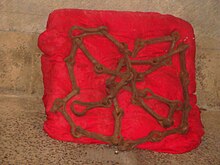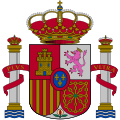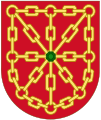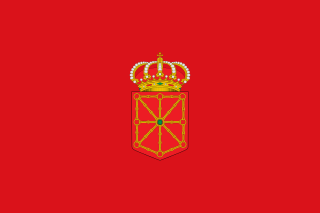
Navarre, officially the Chartered Community of Navarre, is a foral autonomous community and province in northern Spain, bordering the Basque Autonomous Community, La Rioja, and Aragon in Spain and Nouvelle-Aquitaine in France. The capital city is Pamplona. The present-day province makes up the majority of the territory of the medieval Kingdom of Navarre, a long-standing Pyrenean kingdom that occupied lands on both sides of the western Pyrenees, with its northernmost part, Lower Navarre, located in the southwest corner of France.

Sancho VII called the Strong was King of Navarre from 1194 until his death in 1234. He was the son and heir of Sancho VI, whom he followed as the second king to hold the title of King of Navarre. Sancho VII was the first to use the chains of Navarre as his blazon, a symbol that later would become the main one of Navarre, and the last member of the Jiménez dynasty, which had ruled since the 9th century.

Zazpiak Bat is a heraldic nickname for the Basque coat of arms which includes the arms of the seven provinces mentioned, stressing their unity. It was designed by the historian Jean de Jaurgain in 1897 for the Congrès et Fêtes de la Tradition basque celebrated at Saint-Jean-de-Luz.

The Kingdom of Navarre, originally the Kingdom of Pamplona, was a Basque kingdom that occupied lands on both sides of the western Pyrenees, alongside the Atlantic Ocean between present-day Spain and France.

Fuero, Fur, Foro or Foru is a Spanish legal term and concept. The word comes from Latin forum, an open space used as a market, tribunal and meeting place. The same Latin root is the origin of the French terms for and foire, and the Portuguese terms foro and foral; all of these words have related, but somewhat different meanings.

The mythology of the ancient Basques largely did not survive the arrival of Christianity in the Basque Country between the 4th and 12th century AD. Most of what is known about elements of this original belief system is based on the analysis of legends, the study of place names and scant historical references to pagan rituals practised by the Basques.

The coat of arms of Spain represents Spain and the Spanish nation, including its national sovereignty and the country's form of government, a constitutional monarchy. It appears on the flag of Spain and it is used by the Government of Spain, the Cortes Generales, the Constitutional Court, the Supreme Court, and other state institutions. Its design consists of the arms of the medieval kingdoms that would unite to form Spain in the 15th century, the Royal Crown, the arms of the House of Bourbon, the Pillars of Hercules and the Spanish national motto: Plus Ultra. The Monarch, the heir to the throne and some institutions like the Senate, the Council of State and the General Council of the Judiciary have their own variants of the coat of arms.

The blazon of the coat of arms of the Princess of Asturias is given by a Royal Decree 979 on 30 October 2015 which was an amendment of the Royal Decree 1511 dated Madrid 21 January 1977, which also created her guidon and her standard.

The arrano beltza is an ancient Basque and Navarre symbol depicting a black heraldic eagle upon a yellow background. Today, it is mostly used by Basque nationalists as a symbol of sovereignty and independence.

The Fueros of Navarre were the laws of the Kingdom of Navarre up to 1841, tracing its origins to the Early Middle Ages and issued from Basque consuetudinary law prevalent across the (western) Pyrenees. They were a sort of constitution which regulated the social order and defined the position of the king, the nobility, and the judicial procedures, which meant that the royal decisions needed to conform to the provisions set out by the charters.
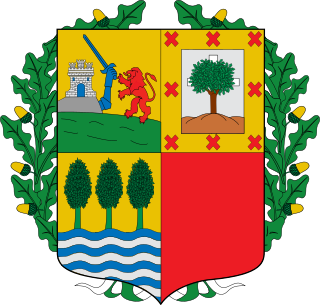
The current Basque coat of arms is the official coat of arms of the Basque Country, Autonomous community of Spain. It consists of a party per cross representing the three historical territories of Álava, Gipuzkoa and Biscay, as well as a fourth, void quarter. The arms are ringed by a regal wreath of oak leaves, symbolic of the Gernikako Arbola. The fourth quarter constituted since the late 19th century the linked chains of Navarre; however, following a legal suit by the Navarre Government claiming that the usage of the arms of a region on the flag of another was illegal, the Constitutional Court of Spain ordered the removal of the chains of Navarre in a judgement of 1986.

The Coat of arms of Balearic Islands is described in the Spanish Law 7 of November 21, 1984, the Law of the coat of arms of the Autonomous Community of Balearic Islands. Previously, by Decree of the Interinsular General Council of August 7 and 16, 1978, adopted the coat of arms as official symbol of the Balearic Islands.

The bat is a heraldic symbol sometimes used as a charge, but most prominently used as a crest on or around the crown in municipal arms of the former Crown of Aragon—specifically in Valencia, Catalonia and the Balearic Islands.
The Juntas Generales are representative assemblies in the Southern Basque Country that go back to the 14th century. They are the Foral Parliament of the Basque Country were - and are - Foral Parliament of Biscay, Foral Parliament of Gipuzkoa, Foral Parliament of Alava, Foral Parliament of Navarre and Parliament of Navarre and Béarn. The equivalent in Navarre was the Cortes—or The Three States, roughly House of the Commons—to become the present-day Parliament of Navarre.

The Coat of arms of the Second Spanish Republic was the emblem of the Second Spanish Republic, the government that existed in Spain between April 14, 1931, when King Alfonso XIII left the country, and April 1, 1939, when the last of the Republican forces surrendered to Francoist forces at the end of the Spanish Civil War.
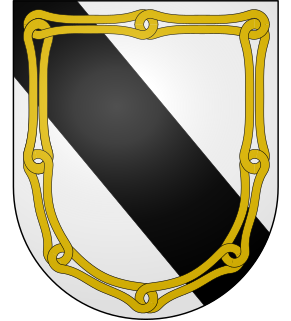
The House of Zúñiga is a Spanish noble lineage who took their name from their domain. Various members of the family were distinguished in the service of the Spanish crown in Europe and the Americas as viceroys, governors, military, diplomats, writers and members of religious orders. Charles I of Spain in 1530 named two members of the family, the Duke of Béjar and Plasencia and the Count of Miranda del Castañar, among his Immemorial Grandees, while eight members of the family were inducted into the Order of the Golden Fleece.

The flag of Navarre, the flag of the autonomous community of Navarre, was designed in 1910 by Arturo Campión, Julio Altadill, and Hermilio de Oloriz. In 1910, the design was approved by the Provincial Council of Navarre and it was sanctioned by the Organic Law of Reintegration and Improvement of the Regional Government of Navarre of August 10, 1982, which was established in Article 7.2: "The flag of Navarre is red-colored, with a shield in the center."

The coat of arms of Barcelona is the official emblem of the City Council of Barcelona, the capital of Catalonia, has its origin in the Middle Ages, these arms were first documented in 1329. The Government of Catalonia conferred the coat of arms and the flag as official symbols of the municipality in 2004. It has an escutcheon in lozenge which is commonly used in municipal coats of arms of cities in Catalonia. Currently the City Council of Barcelona also uses an isotype based on the heraldry of the city.

The coat of arms of Castile was the heraldic emblem of its monarchs. Historian Michel Pastoureau says that the original purpose of heraldic emblems and seals was to facilitate the exercise of power and the identification of the ruler, due to what they offered for achieving these aims. These symbols were associated with the kingdom, and eventually also represented the intangible nature of the national sentiment or sense of belonging to a territory.
The Gamazada is the popular reaction in Navarre in 1893 and 1894 to when the Spanish finance minister of the Liberal Party under Prime Minister Sagasta, Germán Gamazo, tried to suppress the fueros that had been established in the Compromise Act of 1841. It caused a huge uproar among the people and institutions of Navarre, with demonstrations and petitions.


